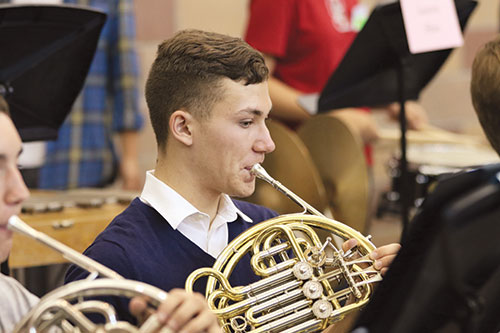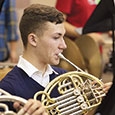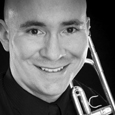Whenever brass students are underperforming or producing an uncharacteristic tone for their instrument, many educators address the use of air. Common air concepts that often come to the forefront include speed, volume, inhalation, exhalation, and temperature. Many educators employ a uniform breathing pedagogy across multiple instrument groups (i.e. a brass sectional or full band rehearsal). However, using identical approaches to teaching breathing can lead some instrument groups to less desirable results. This is especially true when considering the natural resistance of high brass versus low brass instruments. For improved results, it is important that common breathing pedagogy be supplemented with concepts that apply to each individual brass instrument.

Trumpet
The trumpet is perhaps the trickiest instrument to work with when it comes to using air, and it is the most in need of individualized pedagogy. We have all seen trumpet students who continue to struggle with flow and resonance, despite efforts to get them to relax and play more efficiently. Because it is the most resistant instrument in the brass family, overblowing can quickly lead young students astray. Such common band room instructions as “breathe down low” or “use more air” will often lead trumpet students to attempt to push too much energy into such a small mouthpiece.
There are pedagogical solutions that will keep your trumpeters on the right path. When discussing inhalation with your trumpet students, it is advantageous to instruct them to breathe higher – up to the collarbone. A higher breath does not imply that they will automatically become tense in areas around the neck and throat. Rather, the students will be prepared to release air in a healthier manner that is more conducive to resonance on such a highly resistant instrument. A great way to learn how this feels is to try to suck air into the lungs – a technique that was taught by Arnold Jacobs. To try this, start by placing your hand on your lips where a mouthpiece would be, and try sucking air until the lungs are full to the top. At this point, the lungs are full and the air is instantly ready for fast release.
When discussing exhalation, or flow of air, it is critical to avoid encouraging trumpet students to blow. A healthier approach for trumpeters would be to think of merely releasing air. Trumpet virtuoso Rafael Mendez repeatedly claimed that the trumpet requires conversational air. When a person is speaking, air is leaving the body so slowly that it is very hard to detect. Allowing trumpeters to explore operating the instrument with less air while breathing in a higher and more relaxed manner can lead them to increased resonance and allow them to pursue a much more efficient level of play.
Horn
The horn can be a daunting instrument to address from the podium. Because the instrument has such a wide range, a one-dimensional approach to breathing instruction can lead to diminished results. For this instrument, it is highly recommended that different approaches for high and low range be explored.
When horn players need to perform in the higher range of the instrument (around written G5), overblowing and overexertion are likely problems. A style of breathing and support that allows resonance and resistance to co-exist is essential. Therefore, an approach that is similar to breathing for the trumpet is best.
The lower range of the horn (approximately written G3) offers quite a bit of a departure from what has been discussed so far. Because of the more open feel and lack of resistance, a relatively traditional pedagogy might prove effective. Concepts such as breathing from the bottom up, thinking the syllable ahh or ohh, and the idea of fogging the mirror with warm air can help students add relaxation and resonance within this range. However, one element that should not be overlooked is the inhalation speed for notes within this range. A slower breath that allows the throat to relax is more likely to lead the student to success with an attack in this register as opposed to one that’s fast and high.
Low Brass
The larger nature of low brass instruments requires a somewhat different pedagogy compared to high brass. With these instruments any methodology should be more concerned with flow and connectivity than with resistance. In general, the low brass family is where most of the common breathing and air concepts that have been taught for years can still prove effective.
For inhalation, I prefer the concept that Arnold Jacobs advocated: the huge yawn. If you imagine an inhalation that is similar to a huge yawn, your body relaxes and opens in a way that is perfect for the high-flow, low-resistance style needed to play a low brass instrument. The sensation of filling the lungs from the bottom sets up students to play with a good attack. For a fast breath, trying to suck in air quickly as mentioned above works wonderfully.
Air flowing through the instrument should move faster than a conversational rate and in higher volume. In other words, the player should detect the air leaving the body. This is a much more active sense of flow than used for high brass, and blowing the air across the embouchure should be encouraged. As with the higher brass instruments, watch out for students overblowing, but it is less likely in low brass instruments.
Tuba
Tuba pedagogy represents a substantial departure from the high brass and is moderately different even from the other low brass instruments. Substantially more air volume is moving through the instrument relative to other brass instruments. Therefore, a more individualized approach towards the tuba should be cultivated.
The concept of sucking in air still brings tremendous benefit, but students should use the syllable oh for inhalation and exhalation. Have students try this without the tuba; the sound of the inhalation and exhalation should be the same. When done correctly, the student’s body should naturally expand as the lungs fill to capacity. In comparison to trombone and euphonium, everything is bigger, slower, and wider.
Conclusion
The above techniques can be customized as needed for all ranges of all instruments. Generalized pedagogies, as helpful as they intend to be, will always have limitations. The most ideal situation is that each educator explores and develops individualized wind pedagogy that meets the needs for each brass instrument.






